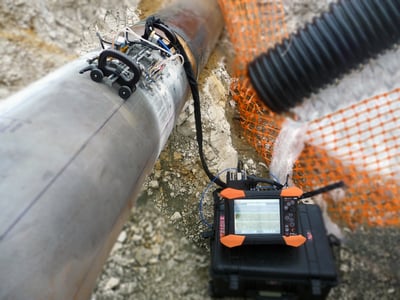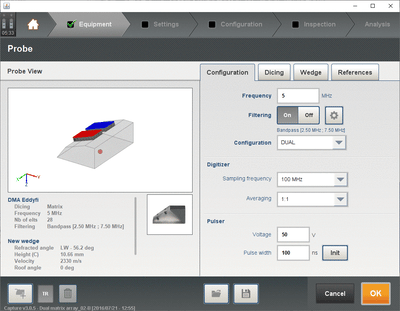Dissimilar Metal Welds are borne from fusing CRA to carbon steel. They are subject to thermal stresses and expansion at independent rates, potentially resulting in low ductility cracking near the fusion line or Lack of Fusion (LOF) at the weld bevel. Dissimilar girth weld inspection, including the weld root, is therefore critical when it comes to the overall assessment of CRA cladding of pipelines servicing the oil, gas and petrochemical sector.
While conventional ultrasonic testing (UT) is regularly accepted for weld examination, DMWs present a unique challenge that limits inspection capability. The different materials skew shear wave transmission and detecting and sizing defects at the surface, root and in the volume of a dissimilar metal weld becomes very difficult. Difficult… but not impossible. Inspection can be performed using longitudinal waves in half-skip mode (half-vee) but requires removing the cap to fully inspect the weld root, volume and upper area.
We present a better, Beyond Current, solution.
The M2M Gekko® is a multi-technique tool that offers Phased Array Ultrasonic Testing (PAUT) and Time-of-Flight-Diffraction (TOFD) for improved efficiency in ultrasonic inspection. Industry recommends the use of linear and dual probes in Transmit-Receive Longitudinal (TRL) mode to overcome transmission problems through dissimilar materials. With the use of Dual Linear Array (DLA) and Dual Matrix Array (DMA) probes combined with the powerful Gekko advanced phased array flaw detector, technicians can effectively evaluate CRA-clad dissimilar metal welds with confidence. And now with the 64:128 configuration, the Gekko can use DLA and DMA with larger apertures allowing focusing over longer distances for improved sensitivity over the traditional probes available on the market.

We’ve gone beyond removing the challenges associated with dissimilar girth weld inspection to making assessments as easy as using a three-click calibration tool. The entire inspection procedure can be configured directly through inspection and analysis software called Capture™. Read more about the inspection of welds with Corrosion Resistant Alloy cladding in our application note.

When it comes to ensuring the integrity of pipelines responsible for transporting contents that could lead to catastrophic results if exposed through a leak, it’s important to regularly evaluate the Dissimilar Metal Welds employed to prevent just that. Eddyfi Technologies offers the proven solution for repeatable, actionable, meaningful and preventative data results. Contact us to discuss your NDT inspection requirements today.





.png)